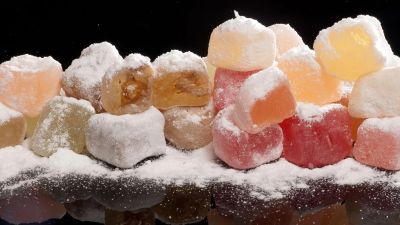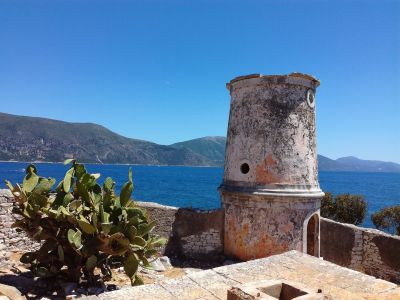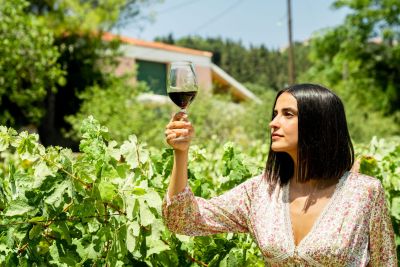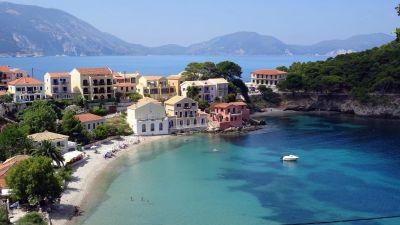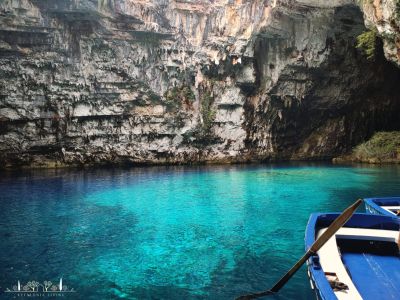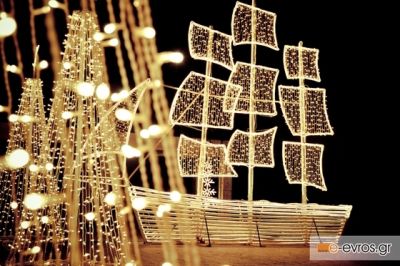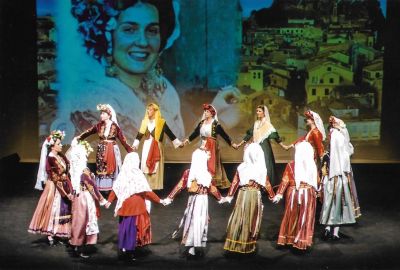ROMAN KEFALONIA, THE ARCHEOLOGICAL SITES OF FISKARDO AND SKALA
For us Italians, lucky inhabitants of a country rich in historical finds unique in the world and incredible architectural beauties, the discovery of Roman settlements during an excavation activity does not represent a rare and particularly significant event. Should you therefore visit the Fiskardo cemetery and the Roman villa of Skala during your holidays in Kefalonia? Absolutely yes! Coming across Roman finds abroad, in addition to demonstrating that we are not the first "Italians" to have fallen in love with this enchanting island, reminds us how intertwined the history of Mediterranean countries is and how much these contacts have enriched all the civilizations involved... And if you're traveling with little explorers, this break from the beach is sure to be a great adventure for them!
KATAVOTHRES, A MISTERY ON THE SEA
Did you know that Kefalonia is famous for one of the most amazing geological phenomena in the world? The "katavothres", the best known sinkholes on the island, are about two kilometers from Argostoli on the coastal road to Lassi. The sea water creeps here between the rocks, disappears, flows in underground rivers fed by rainwater and re-emerges in brackish composition on the other side of the island!
SOUVENIR, WHAT TO BUY IN KEFALONIA
Souvenir are the crowning glory of every trip. How to choose something that does not end up irretrievably in a drawer as soon as we return home but, on the contrary, continues over time to make us feel a little on vacation or even entice those who have not been there to leave? What souvenirs did you buy in particular in Kefalonia? Tell us the most original or your favorite, let's prepare together a wish list for next summer!
INTERNATIONAL WEEKEND OF THE LIGHTHOUSE: WHAT TO VISIT TODAY, AUGUST 21st 2022, IN KEFALONIA
On the occasion of the International Lighthouse Weekend, today Sunday 21 August 28 lighthouses throughout Greece will open to the public between 10 a.m. and 8 p.m. Visitors will have the opportunity to learn more about the contribution of lighthouses to navigation safety but also their great significance in terms of cultural heritage. Since many lighthouses are now in a state of neglect and suffer from vandalism, the event aims to raise public awareness of the need to preserve these important witnesses of maritime history before they are irretrievably lost.
KEFALONIA, THE PROGRAM FOR A RAINY DAY
The climate of Kefalonia is typically Mediterranean, with mild, rainy winters and hot, sunny summers. Even in the hottest season, especially in June and September, however, a capricious wind may bring some clouds or a passing storm. This is precisely why the island is so green! No problem, a cloudy day is the ideal opportunity to discover that Kefalonia offers much more than its beaches.
KEFALONIA, WHAT TO SEE IN 7 DAYS ON THE ISLAND?
How many days does it take to visit Kefalonia? You may not like the answer: many, many more than you are likely to have available. Not only for the size of the island and therefore the large number of beaches, villages and postcard views not to be missed, but also because a holiday in Kefalonia can become a state of mind: the island should be savored slowly, between a coffee and a souvlaki, because its relaxing atmosphere is even better than its exceptional beaches.
KEFALONIA, A 4 HOURS TOUR IN THE CENTER OF THE ISLAND (MONASTERY OF SAINT GERASIMOS, LAKE OF MELISSANI, CAVES OF DROGARATI, AGIA EFIMIA, MYRTOS BEACH)
Donkeys trudging along steep cobblestone streets, blue and white houses, bougainvillea pergolas, elderly people with sun-baked skin playing tavli (backgammon) sitting outside a tavern ... in the collective imagination, the Greek islands are all the same. Kefalonia is the best place to realize how different this tourist representation is from reality. A few days will not be enough to visit this corner of paradise! Beaches washed by turquoise waters, pine forests and aromatic plants, picturesque fishing villages in pastel colours overlooking the sea… The largest of the Ionian islands offers a lot to those who want a holiday in contact with unspoiled nature but also to contemporary history enthusiasts.
KALLIKANTZAROI, THE EVIL SPRITES OF CHRISTMAS
Did you wake up this morning and found your Christmas decorations upside down? Has anyone eaten the cake you had left over in the fridge? If you don't have a mischievous cat or child to blame, you'd better think about the Kallikantzaroi!
KARAVAKIA, CHRISTMAS OF THE SAILORS
A boat decorated with Christmas lights creates a warm, welcoming and very Greek atmosphere.
MUSIC AND FOLKLORE: DANCING GREECE
With the recent death of Mikis Theodorakis, a well-known composer, a man with an adventurous life and an important political commitment, Greece hands over to history one of its most representative icons, the sirtaki.
From its first notes, the soundtrack of Zorba the Greek evokes the deep blue of the sea, the sun and the warmth of Greece, inviting you to dance and let yourself be overwhelmed more and more by the joy of dance. Although sirtaki was born only in 1964 and does not represent an authentic component of the Greek tradition, with its invitation to dance it has helped to make people talk about Greece and to make the world fall in love with this land populated not only by gods, sailors and thinkers, but also by passionate dancers.



